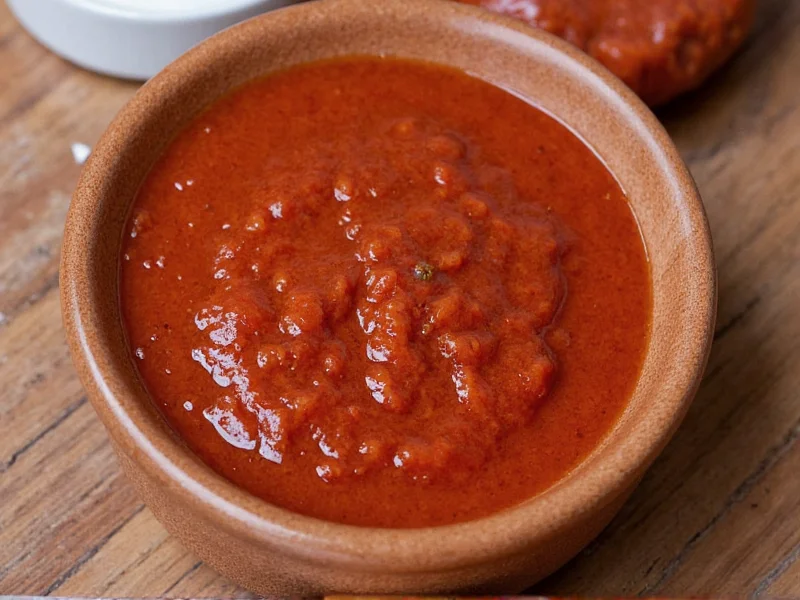Ancho chile sauce represents one of Mexico's most versatile culinary staples, originating from the careful transformation of fresh poblano peppers into their dried form. This process concentrates the pepper's natural sugars while developing nuanced earthy and fruity notes that define authentic Mexican cuisine. Unlike many commercial hot sauces, traditional ancho chile sauce delivers depth rather than intense heat, typically measuring between 1,000-2,000 Scoville Heat Units—comparable to a jalapeño but with significantly more complexity.
Understanding Ancho Chiles: The Foundation of the Sauce
Ancho chiles begin as poblano peppers that undergo sun-drying until they darken to a deep burgundy color and develop a wrinkled texture. This drying process transforms their flavor profile dramatically:
| Pepper Stage | Flavor Characteristics | Common Uses |
|---|---|---|
| Fresh Poblano | Mild, grassy, slightly bitter | Rajas con queso, stuffed peppers |
| Dried Ancho | Prune, raisin, coffee, tobacco notes | Moles, sauces, spice blends |
The name "ancho" means "wide" in Spanish, referring to the pepper's broad shape. When properly rehydrated and blended, these peppers create a sauce with remarkable depth that forms the base for many traditional Mexican dishes.
Traditional Ancho Chile Sauce Preparation
Authentic preparation requires careful attention to detail. Professional chefs follow these essential steps:
- Stem and seed dried ancho chiles (removing seeds reduces bitterness)
- Toast lightly in a dry skillet to enhance flavor complexity
- Rehydrate in hot water or broth for 15-20 minutes until pliable
- Blend with garlic, cumin, and a touch of vinegar or citrus
- Strain through a fine mesh sieve for smooth texture
- Simmer with additional seasonings to develop flavors
The quality of ancho chile sauce depends significantly on the freshness of the dried peppers. Older chiles lose their vibrant flavor and develop mustiness. When selecting dried anchos, look for deep reddish-brown color (not black), pliable texture, and a rich, fruity aroma.
Flavor Profile and Culinary Applications
Ancho chile sauce offers a distinctive flavor profile that makes it indispensable in Mexican cooking:
- Sweetness: Natural fruit notes reminiscent of dried plums and raisins
- Earthiness: Undertones of coffee and cocoa
- Acidity: Brightness from added vinegar or citrus
- Heat: Mild warmth that builds gradually (1,000-2,000 SHU)
Chefs value ancho chile sauce for its ability to enhance rather than dominate other ingredients. Unlike vinegar-based hot sauces, it integrates seamlessly into complex dishes. Common applications include:
- As a base for mole poblano and other complex sauces
- Marinades for chicken, pork, or beef (especially carnitas)
- Enchilada sauce when combined with tomatoes
- Moisture and flavor component in tamale fillings
- Drizzled over eggs or roasted vegetables for finishing touch
Ancho Chile Sauce vs. Similar Products
Many consumers confuse ancho chile sauce with other Mexican sauces. Understanding these distinctions helps select the right product for specific recipes:
| Sauce Type | Primary Ingredients | Heat Level | Best Uses |
|---|---|---|---|
| Ancho Chile Sauce | Dried ancho chilies, garlic, vinegar | Mild (1,000-2,000 SHU) | Moles, marinades, enchiladas |
| Adobo Sauce | Chipotle peppers, tomatoes, vinegar | Medium (2,500-8,000 SHU) | Adobo marinades, stews |
| Chile Colorado | Guajillo chilies, tomatoes | Mild-Medium (500-2,500 SHU) | Beef dishes, tamales |
The key difference between ancho chile sauce and adobo sauce lies in their base ingredients—anchos provide fruitiness while chipotles (smoked jalapeños) in adobo deliver smokiness. Many commercial "ancho sauces" actually blend multiple chilies, so checking ingredient lists is essential for authentic recipes.
Storage and Shelf Life Considerations
Proper storage maintains the sauce's complex flavor profile. Homemade ancho chile sauce typically lasts:
- Refrigerated: 1-2 weeks in airtight container
- Freezed: 3-6 months in ice cube trays for portioning
- Canned: Commercial versions last 1-2 years unopened
Signs of spoilage include mold growth, sour smell, or separation that doesn't reincorporate when stirred. For best flavor, use homemade sauce within one week. The natural oils in the chilies can separate over time—simply reheat gently and whisk to recombine.
Authentic Recipe Adaptation Tips
When working with ancho chile sauce in traditional recipes, consider these professional techniques:
- Bloom spices in the sauce before adding liquids to maximize flavor extraction
- Balancing acidity with a pinch of sugar if the sauce tastes too sharp
- Thickening naturally by reducing the sauce uncovered rather than using thickeners
- Layering flavors by adding the sauce at different cooking stages
For those seeking authentic ancho chile sauce flavor without making it from scratch, look for products listing only dried ancho chilies, water, vinegar, garlic, and salt as ingredients. Avoid sauces containing tomato paste or artificial flavors, which alter the traditional profile.











 浙公网安备
33010002000092号
浙公网安备
33010002000092号 浙B2-20120091-4
浙B2-20120091-4